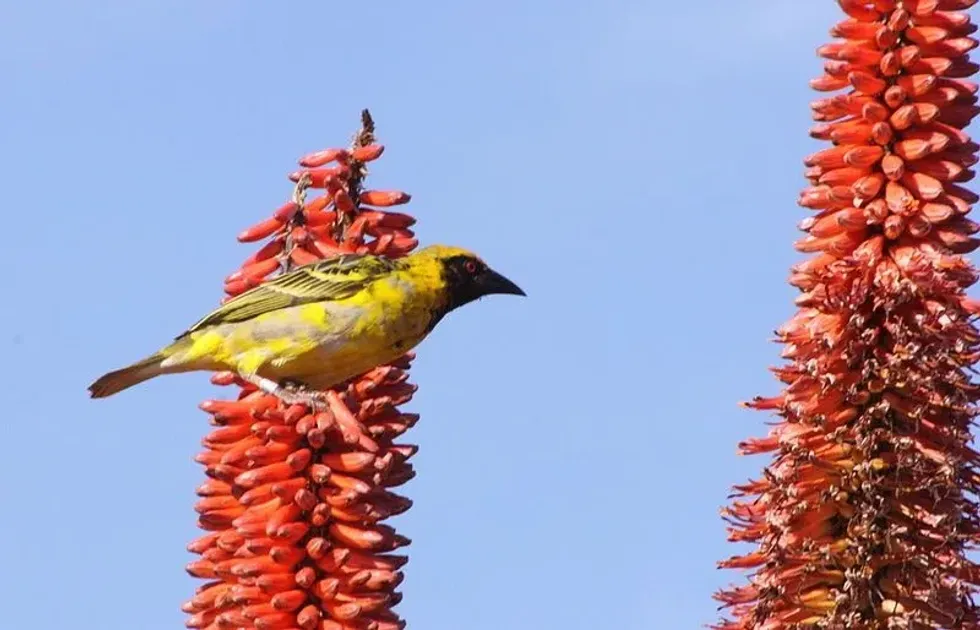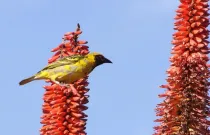The village weaver (Ploceus cucullatus) is a bird belonging to the Ploceidae family. These birds are also known as black-headed weavers or spotted-backed weavers.
The breeding male birds of this family are known for the beautiful and elaborate nests they weave. They build such nests in giant colonies, with the entrance of the nest facing downwards. These birds can be found in a range of habitats, like woodlands, gardens, towns, and so on.
The appearance of males and females of this species differ in many aspects, but they both have yellow and black wings. These birds are quite vocal and can be heard chattering amongst themselves.
Their vocalizations are especially loud during the breeding season. Village weavers have an omnivorous diet and feed on insects as well as seeds and grains.
This has led to them becoming crop pests in many areas. They are also harmful to the native birds of the islands of the Caribbean and the Indian Ocean, where their population has been introduced.
To learn more about the village weaver bird, keep reading! You can also check out these secretary bird facts, or great green macaw facts.
Village Weaver Interesting Facts
What type of animal is a village weaver?
A village weaver is a kind of bird. This bird is called this as it usually being found near villages.
What class of animal does a village weaver belong to?
Village weaver birds (Ploceus cucullatus) belong to the class Aves. They are a part of the bird family Ploceidae, which includes several other species of weavers. The specialty of weaver birds, including village weavers, is the intricate nest the male weavers weave using vegetation.
How many village weavers are there in the world?
Though the exact population of village weavers is not known, they are pretty abundant in their natural range and habitats. These birds are also quite adaptable to most kinds of surroundings.
Where does a village weaver live?
The village weaver is part of the Ploceidae family, having Old World members, with their populations limited to mostly Africa and Asia. Village weavers are native to Sub-Saharan Africa, but they have been introduced in Hispaniola (an island in the Caribbean), Reunion, and Mauritius (islands in the Indian Ocean).
What is a village weaver's habitat?
This bird species is adaptable to different kinds of habitats. They can be found in savanna, woodland, fields, gardens, and human habitations like villages, near hotel grounds, and towns.
Who do village weavers live with?
Village weavers are social birds and can be found living in large colonies. Depending on the size of the tree, 8-100 nests can be found.
How long does a Village Weaver live?
In captivity, a village weaver can live for 24 years.
How do they reproduce?
The breeding season differs for the different populations of village weavers. The breeding male weaves a nest to attract a potential mate. They take 9-14 hours to complete building a single nest.
Once the nest is accepted by a female, the male makes an entrance to the nest, which is lined with grass and feathers by the female. After successful mating, the female lays two to three eggs. The eggs are incubated by the female for around 14 days before they hatch.
What is their conservation status?
The conservation status of the village weaver has been marked as Least Concern by the International Union for Conservation of Nature or IUCN. This Old World species is found quite abundantly and is not threatened.
Village Weaver Fun Facts
What do Village Weavers look like?

In this weaver bird species, the male and female birds have different appearances. Additionally, the breeding male and non-breeding male birds also appear different in some respects.
While the wings remain yellow and black in both kinds of male birds, the breeding male birds have a chestnut nape with a black head and bill, while the non-breeding male population has a yellow head and olive crown.
The upper and under plumage are yellow and black and yellow, respectively in the breeding male birds, while it is gray and whitish, respectively in the non-breeding males.
Adult female village weaver birds have pale yellow under plumage, yellow with olive streaks upper plumage, and yellow and black wings. They all have strong conical bills and red eyes.
How cute are they?
Village weaver birds are quite cute and charming. Apart from their appearance, some of their behavior and habits also add to their cuteness.
How do they communicate?
The village weaver bird species are known to be quite vocal. These birds live in large colonies and can be heard chattering with each other. Their calls include sounds like 'cluck', 'chuck-chuck', and buzzes. Village weavers are more vocal during the breeding season. They also chirp when they've found food.
How big is a village weaver?
The length of a village weaver (Ploceus cucullatus) is between 5.9-6.6 in (15-17 cm). The Southern masked weaver, native to South Africa, has a length between 4.3–5.7 in (11–14.5 cm), so the village weaver is slightly bigger in length.
How fast can a village weaver move?
Village weaver birds fly swiftly in flocks, following a bounding flight pattern, in which they alternate between short bursts of flapping their wings and keeping them folded against their body.
How much does a village weaver weigh?
The weight of a village weaver bird is between 1.1-1.5 oz (32-45 g).
What are the male and female names of the species?
The male and female birds of this species are known as male village weaver birds and female village weaver birds, respectively.
What would you call a baby village weaver?
A baby village weaver bird is known as a chick or nestling.
What do they eat?
The village weaver species mostly feed on different kinds of insects like ants, beetles, and locusts. They tend to consume insects on a larger scale during the breeding season.
They also eat grains and seeds. Hence, in some areas, they are considered to be crop pests. Other weaver species, like the Southern masked weavers and the lesser masked weavers, have a similar diet.
Are they poisonous?
The village weaver (Ploceus cucullatus) is not poisonous.
Would they make a good pet?
Village weavers are not known to be domesticated. However, they can be seen in some zoos.
Did you know...
The first English name to be given to village weavers was 'Weever Oriole'. This name was given by a British ornithologist known as John Latham.
Some birds of prey like Gabar goshawks, little sparrowhawks, and purple herons are predators of village weavers.
Why do weavers destroy their nests?
In various weaver species, the breeding male birds are known to build or weave elaborate nests using different plant materials during the breeding season. The nests are built to attract female birds to mate.
However, if a nest is repeatedly rejected by potential female mates, the male weavers destroy the nest and start building all over again, using new materials.
How high can they fly?
The exact height at which village weavers fly is not known. However, since these birds usually reside in tall trees or any kind of tall structure, it can be assumed that they can fly several feet above the ground.
Here at Kidadl, we have carefully created lots of interesting family-friendly animal facts for everyone to discover! For more relatable content, check out these Birds of Paradise facts and Tawny Owl facts.
You can even occupy yourself at home by drawing one on our village weaver coloring pages.










